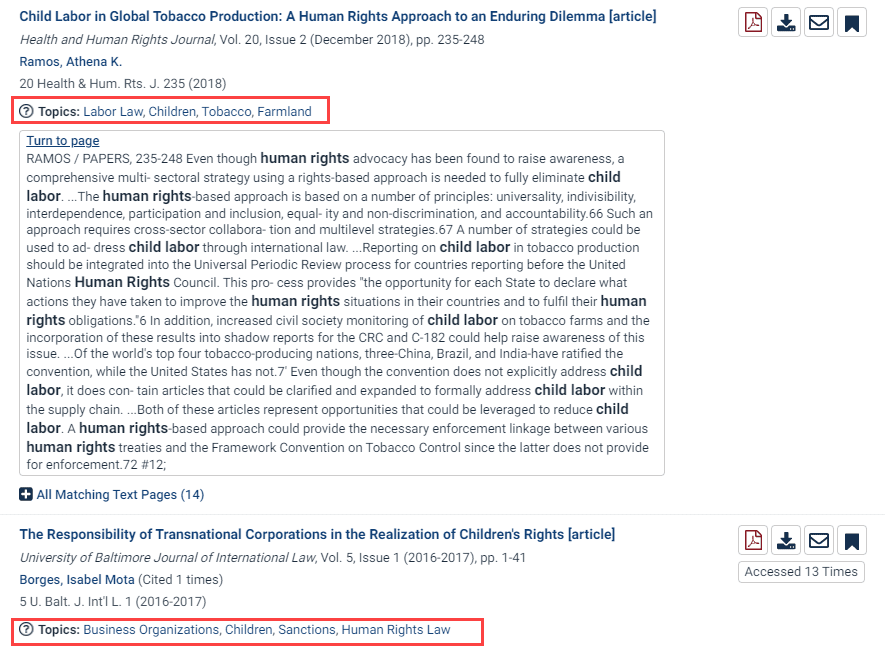If you’ve spent a fair amount of time in the Law Journal Library, you may be familiar with HeinOnline’s Topics.
Using a combination of human curation along with natural language processing and machine learning, we’ve extracted narrow research concepts from each article in the Law Journal Library database. This has provided a robust foundation of more than 1,500 distinct multidisciplinary concepts which we’ve used to categorize each and every Law Journal Library document.
We call these concepts “Topics.” Every document in the Law Journal Library is assigned at least one of these Topics, and these concepts have been made available for users when browsing and searching.
Quick Refresh: Using Topics in the Law Journal Library
The Topic Facet
Our users most frequently encounter these concepts by using the Topic facet, found within the filter options on the left-hand side of any Law Journal Library search results. After performing a query, the HeinOnline search engine provides a list of the most-frequently assigned Topics among the results of that query.
Open the Topic facet to view the concepts relevant to your search. Choose any concept to filter your results by that Topic.

Topics within Search Results
Within search results, users can also see the Topics that have been assigned to each result to get a general idea of the scope of the article before they dive in any further.

Using Topics in an Advanced Search
Users can additionally utilize Topics when performing an Advanced Search in the Law Journal Library database. Construct any query, and then choose one or more Topics under which the search engine should perform that query.

Topics in the Page Viewer
When paging through any document, users can also see the Topics that have been assigned to that content. Click any of the Topics to be taken to a list of all Law Journal Library content that falls under the concept.

Topics in “More Like This”
Within the More Like This tool for any document, users can also select the Topics button to see a more in-depth view of how the article was assigned those concepts.

Topics on Author Profiles
Finally, head to an author’s profile page to see the Topics about which they frequently write listed in their biographical information. If the author’s profile has been enhanced, see those Topics in the Explore This Author tool, as well.

More Topics Leads to an Enhanced Topic Taxonomy
As we refine and expand our machine learning, our collection of more than 1,500 of these Topics continues to grow. The fact that we’re continually able to extract such an extensive number of research concepts from our material demonstrates the incredible scope of HeinOnline over a multitude of disciplines. However, we realize that it can be a lot to sift through when you aren’t quite sure what you’re looking for.
To make our Topics even more intuitive, discoverable, and user friendly, we’ve been working diligently behind the scenes to categorize them within a multi-level taxonomy. The same Topics are available, but they’re now organized into a logical hierarchy that allows users to drill down from broad areas of study to their specific topics of interest.
This taxonomy is made up of three levels: Categories, Subjects, and our existing machine-learned Topics. Think of these three levels like an inverted pyramid:
Categories are the most broad—overarching disciplines that include Subjects and Topics within them. There are currently 5 of these broad Categories.
Subjects are more refined areas of study that fall within a particular Category and include relevant Topics within them. There are currently 38 identified Subjects.
Topics, as we already know, are HeinOnline’s pre-existing narrow research concepts that now fall within the larger Subjects and Categories. We’re at just over 1,500 Topics, and still growing.

For example, in the visual below, the Category of “Social Sciences” breaks down into Subjects like “Criminal Justice” and “Gender and Sexuality,” which further break down into more specific Topics, like “Victims’ Rights” and “Gender Identity.”

Using the New Topic Taxonomy
So what you’re probably wondering is how this new taxonomy comes into play when you, the user, are searching and browsing in HeinOnline. Remember, Topics can still be used exactly as described above, but now there are also some additional tools related to the Categories and Subjects within this enhanced hierarchical structure.
To start introducing the taxonomy into HeinOnline’s Law Journal Library, we’ve added new elements in two places—the Law Journal Library facets and Law Journal Library search results.
Category, Subject, and Topic Facets
Now, when you perform a query in the Law Journal Library, you’ll find Category and Subject facets in addition to one for Topics. Let’s perform a search for “women’s rights” to test out these new elements, starting with the Category facet.
Expand the facet to see that this query applies to all five of our new Categories; however, you’ll also see that it’s most applicable to “Social Sciences” and the “Humanities”. Select one of these Categories to refine the search by that area of study.

Next, let’s take a look at the new Subject facet within the same search. Users will see that, out of our 38 Subjects, “Law,” “Gender and Sexuality,” and “Sociology” are the most relevant to a query regarding women’s rights. Select one of these Subjects to further refine the search—we’ll choose “Gender and Sexuality.”

We can now open up the pre-existing Topic facet that we know and love to take a look at the more specific research concepts that apply to this query, and then refine as necessary.

Subjects and Topics in Search Results
To make your research more efficient, we’ve also extracted the Subjects from each document and made them visible along with Topics in each search result.
A quick glance at the Subjects and Topics assigned to an entry can often provide all the information you need about whether that document is pertinent to your research.

Coming Soon: An Interactive Taxonomy Browse Tool!
Wouldn’t it be neat to interact on a deeper level with the new taxonomy we’ve described? To literally drill down from a broad Category like “Humanities” into its relevant Subjects, and then dig even further into those Subjects’ assigned Topics?
We think so! Stay tuned to the HeinOnline Blog for announcements about just such a tool, coming right to your Law Journal Library in the next few months. Subscribe to the blog now so you don’t miss it!
Got Feedback?
We love to hear how our customers feel about any changes to our platform. If you have thoughts to share, you can fill out the Feedback form found under the Help option within HeinOnline.

You can also contact our dedicated support team at (800) 277-6995, email us, or live chat with us! Or, send us a message on social media—you can connect with us on Facebook, Twitter, or Instagram!



